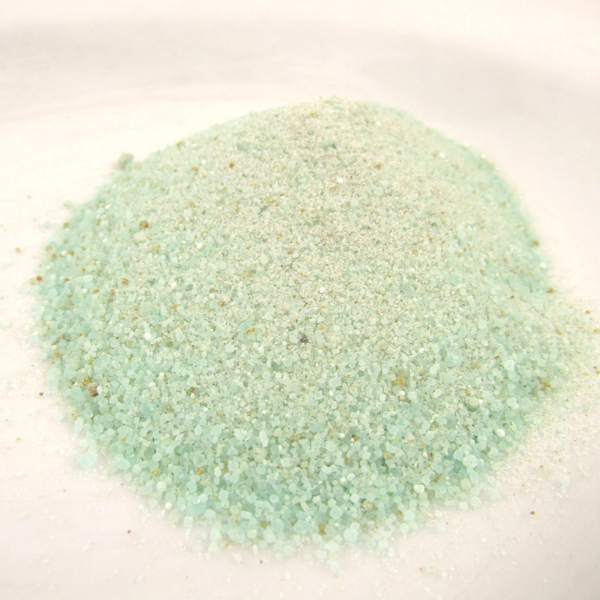Iron (Ferrous Sulfate) is used alone as a mordant, as a color shifter and to increase lightfastness when used in combination with other natural dyes. It also used as a reducing agent for certain types of indigo vats. Iron is a versatile ingredient for the natural dyer. You can add it directly to a dye bath, mordant with iron or iron and alum or tannin, put it in a spray bottle or shift colors by dipping fibers in an iron bath after dyeing.
Iron is very strong, so a little goes a long way and the color results can be dramatic. It reacts with dyes that contain tannin and produces dark brown and gray when combined with tannin-rich dyes.
For example:
- Pomegranate with iron makes a dark olive green
- Madder with iron makes a deep grayish purple
- Tannin with iron makes a grayed purple
- Chestnut with iron makes a medium gray
- Cutch with iron makes a rich chocolate brown

Safe Use of Iron
The iron (ferrous sulfate) we supply is a food grade product but it can be harmful in powdered form to young children and pets. We advise that you follow these safety precautions.
- Keep the iron powder package tightly closed and store away from children and pets. Do not allow children to use iron powder unsupervised.
- If ingested, seek immediate medical attention.
- Measure iron in a well-ventilated area.
- Avoid breathing the steam coming from a hot iron mordant bath and mordant in a well-ventilated area.
- When measuring iron powder, use a dust mask or respirator, apron and gloves.
- Clean any spills immediately and wash utensils promptly after use.
- Iron will stain surfaces, hands and clothing.
- This information is not meant to freak you out but to make you aware that iron should be handled with care.
Amount to use
Use for Weighing Dyes
| Depth of Shade per pound of fiber | Percentage of the Weight of Fiber (WOF) |
| Light | 0.25% |
| Medium | 0.5-0.75% |
| Dark | 1-3%. Dye bath may look nearly black. |
Use for Measuring Dyes
| Depth of Shade per pound of fiber | Amount in Teaspoons |
| Light | 1/16 – 1/8 teaspoon. A tiny pinch will shift colors dramatically. |
| Medium | 1/2-3/8 teaspoon |
| Dark | 1-3 teaspoons. Dye bath may look nearly black. |
Procedure
To make an iron (ferrous sulfate) solution for mordant, color shifting, painting or spraying:
- Weigh or measure iron into a plastic beaker or non-reactive container
- Add approximately 1 cup (225 ml) cold water and stir well. If you are using a large amount of iron, use a larger container and add more water to fully dissolve. You may strain out any undissolved grains of iron with a coffee filter or sieve.
- The iron solution is ready to use. You can add to a dye bath, or put in a spray bottle or use for eco-printing.
Avoid ingesting or breathing the iron spray. It will store well at room temperature in a covered jar or container. Stir before using and keep away from children and pets.
To make an iron (ferrous sulfate) solution for mordanting and color shifting of yarn, fiber or fabrics:
- Fill a dye pot with enough water to hold fibers, and add iron solution and stir well.
- Add fibers, rotating often for the first 15-20 minutes, then make sure they are fully submerged in the iron solution
- Heat the iron mordant bath to 130°F (55°C) and hold for 30 minutes, stirring carefully and constantly to avoid streaks.
- Remove from heat, let cool to handle easily and rinse fibers in cool water.
- For color shifting, immerse your fibers in the cold iron bath after you have first dyed your fibers a base color. Watch your fiber or yarn and remove it when the iron has shifted to the color you desire. This may take only a few minutes, so watch carefully. Your iron bath temperature may still be cold or barely warm, as this reaction works fast.
- Cool the fibers, then rinse in cool water.
- If you want very dark grayed shades, allow the fibers to remain in the bath and bring the temperature to 130°F (55°C), removing when it is the shade you desire. Cotton, linen and hemp will tolerate higher dye bath temperatures, and you can bring those to 180°F (82°C) for darker shades.
Notes
- Protein fibers (wool, silk, alpaca) can feel rough after an iron mordant. Use the least amount of iron possible and lowest temperatures to avoid harshness. Cotton, linen and hemp mordant well with iron, so you may use higher percentages and higher temperatures.
- Thoroughly wash all your iron utensils and pots to avoid staining with residual iron.
- Iron dye baths used for color shifting may be reused several times.
- Dispose of iron bath or iron solution down the drain in municipal areas or in a septic system. Do not dispose in waterways, lakes or streams.
